Motorcycle Investor mag
Subscribe to our free email news
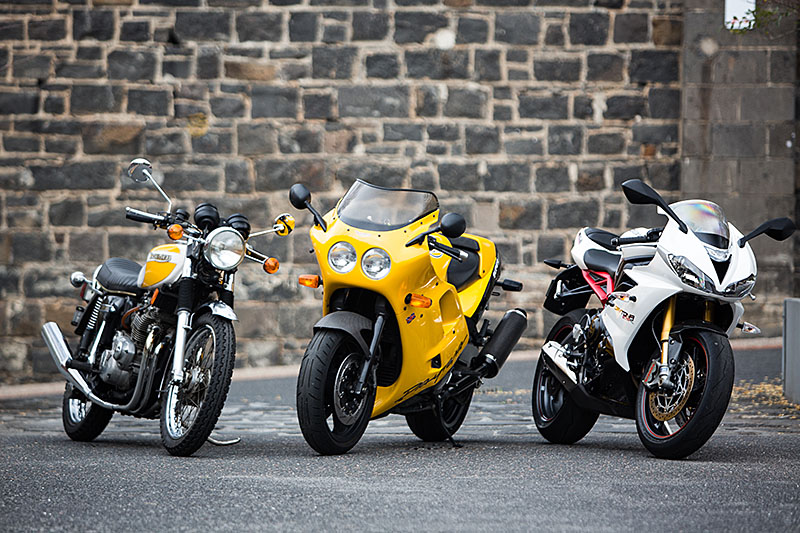
Profile - Triumph's hero Triples across four decades
(updated June 2020)
Triple treats
by Guy 'Guido' Allen; pics by Nathan Jacobs
It’s not often you get to assemble three of Triumph’s hero triples, built at 20-year intervals
It wasn’t so much a plan or even a flash of inspiration, but rather a recognition of the bleeding obvious. Back in 2014, while pondering the Daytona 675R demo bike in the driveway, muggins looked up and spotted the Super III and T160 in the shed. Like the 675, they were the hero performance triple of their era and, by happy coincidence, each was a headliner around 20 years apart: the Trident T160 in 1974, the Daytona Super III in 1994 and the Daytona 675R in 2014.
Each in its own way says a lot about its respective era
and, more importantly, how Triumph was travelling at the
time. Let’s have a bit of a look, shall we?
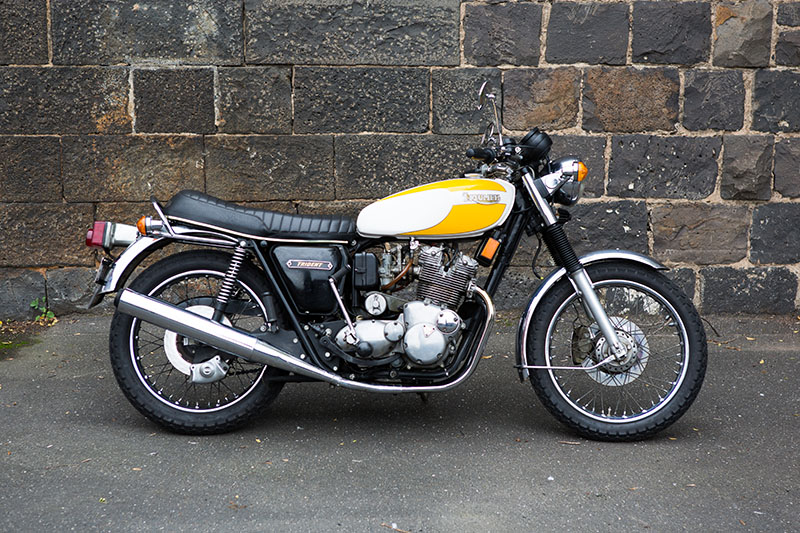
1974 - T160
UK Prime Minister: Harold Wilson
Top of the UK singles charts: David Essex – Gonna
make you a star
Australian Prime Minister: Gough Whitlam
Top of the Australian singles charts: Alvin Stardust – My
coo ca choo
Triumph’s hero triple: Trident T160V
This was the last of the Tridents and it typified the story of Triumph itself in so many ways. Strictly speaking, its predecessor, the T150, was the 1974 leader model for this range. However the T160 had been announced and construction was soon underway at the old BSA factory in Small Heath – some distance away from the Meriden factory, where the twin-cylinder Bonnevilles hailed from.
Let’s roll back a little first, and cover a quick potted
history of the Tridents. The legendary team of General
Manager Bert Hopwood and Chief Designer Doug Hele were, by
the early 1960s, coming to the conclusion that their
much-loved bread-and-butter vertical twin engine needed a
successor. Their belief was that, in being punched out
from 500cc to 650 the powerplant was reaching its limits.
And of course it eventually grew to 750.
The idea of a 500 twin with the third cylinder added had some appeal and design work was begun in 1964. A test engine was running by January 1965, but the decision to produce the bikes was fatally delayed until an unveiling in 1968 for the 1969 model year. Why fatal? Honda unleashed the more sophisticated and more powerful CB750-Four a week after the Trident T150.
Despite the sudden competition from the east, the Triumphs sold well. BSA also built a variant, called the Rocket III. The latter was notable for having its cylinder block tilted a couple of degrees forward, while the Triumph version was dead upright.
As you’d expect, the machines developed over the years, eventually expanding the four-speed gearbox to five. On paper at least, they were losing the performance wars, with mighty machines such as the Kawasaki Z900 arriving on the scene. Despite that, the Tridents had a few things in their favour: a loyal customer base; Much better handling than most of their Japanese competitors; And a remarkable race record.
Honda and Triumph had some legendary battles on USA racetracks, such as Daytona. In 1971 British triples took the top three places in the Daytona 200. The next year they managed first and second in the same event. They also enjoyed incredible success in Europe and particularly on the Isle of Man. One notorious bike, named Slippery Sam after a high-profile oil spill during a continental endurance race, won the IoM Production TT five years in a row, from 1971 to 1975.
For some enthusiasts, the T150V (5-speed, pre-electric start) was the zenith model.
A 1973 management decision to move Trident production from Meriden to Small Heath triggered an infamous strike and blockade at the former factory, lasting 18 months.
In amongst all this drama, the T160 was announced. It
represented a significant and much-needed redesign for the
model, adopting the slant-forward cylinders from the BSA,
electric start, disc brakes on both ends and, to comply
with USA requirements, a gearshift on the left rather than
the traditional right. It was accompanied by a restyle,
with two variants: high handlebars and smaller fuel tank
for America and low ’bars and large tank for the UK.
The example you see on these pages is a hybrid, with
English-style handlebars and USA fuel tank (approx 13
litres), a variant that was popular in Melbourne
(Australia) back in the day.
As it turned out, the T160 was the last of this air-cooled three-cylinder breed, with production starting in November 1974 and ceasing by April 1976. (Twins staggered on for a while, at Meriden.) Triumph had done much of the work to release a bigger (830cc) successor, nominally called the Thunderbird III, but it was not to be.
Tridents are still relatively plentiful on the classic market. Former Triumph staffer Ivor Davies, in his book on the model, says 27,480 were produced over the years, plus 5897 BSA variants. T160s accounted for 7211.
So what are they like to ride? In their day, they were down on power (58 horses) but strong on handling. By far their biggest weak point was the electric start, which seemed to have a short life span.
Time has been kind to them. A well-sorted one is a genuinely enjoyable ride, particularly out in the hills on a decent set of bends. The cornering clearance offered by the fixed footpegs is not great, but sharp steering, a well-thought-out frame and reasonable suspension combine to make it very capable.
Braking from the polished discs varies from respectable in the dry to woeful at first in the wet, until you dry out the discs. That’s very 1970s.
The engine has good midrange and these days it’s cruel to hammer it in the upper rev range. The pushrod design is willing enough but you’re going to shorten its life-span with over-enthusiastic use. A couple of aftermarket solid-state ignitions are offered to replace the fiddly triple points set-up, which can aid starting. Also, a decent modern lithium battery will do wonders for the ability and life-span of the electric starter.
Gearshifting can be grumpy when cold, but improves noticeably once you’re up to operating temp.
Parts are generally very easy to get and remarkably cheap. Tuning and servicing is in the range of a competent and patient home mechanic, with plenty of info available.
The T160 was very much a creature of its time - a genuine all-rounder road bike with a decent turn of speed when you wanted it. In the current far more segmented market, you’d classify it as a naked bike. For late 1974, it was a premium performance machine that turned its hand to anything from commuting to play-racing to touring.
In isolation it was a decent enough thing, but with machines such as the mighty Kawasaki Zed 900 and even monsters like the Honda GL1000 Goldwing appearing on the scene at very competitive prices, it was simply outgunned on the showroom floor.
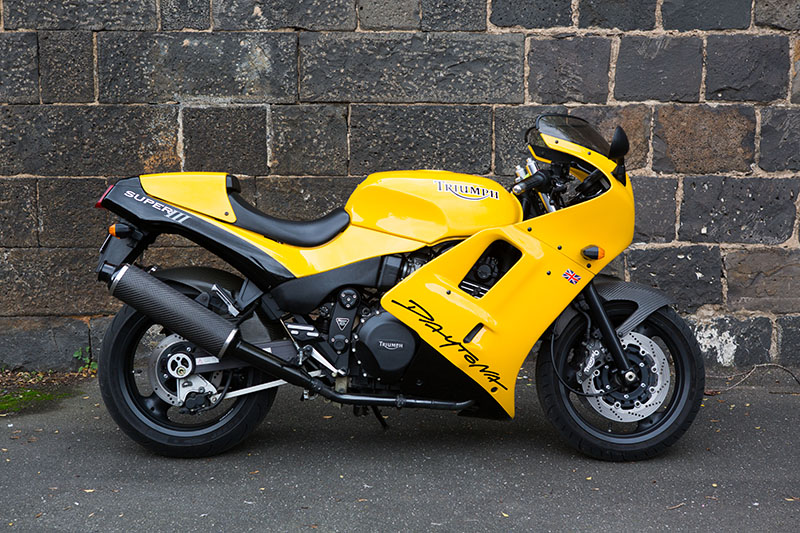
1994 - Daytona Super III
UK Prime Minister: John Major
Top of the UK singles charts: Wet Wet Wet – Love is
all around
Australian Prime Minister: Paul Keating
Top of the Australian singles charts: Wet Wet Wet – Love
is all around
It’s one of life’s little mysteries: how did a businessman best known for his residential housing developments became the owner and savior of one of the iconic motorcycle brands? The answer seems to be a mix of fate and business acumen, along with the willingness by John Bloor to risk somewhere in the vicinity of 100 million pounds.
The announcement that Triumph was back in business at the 1990 Cologne show (for the 1991 model year) was a matter of interest rather than great anticipation for the cynics among us. By this stage we’d heard too many ‘Triumph to rise from the ashes’ headlines over the years to take this one too seriously.
I recall local Triumph enthusiast and expert Phil Pilgrim, of Union Jack Motorcycles, returning from that show saying the bikes looked like real ones and he thought they might be in with a chance. Yeah, right. Whatever. It wasn’t until he turned up months, perhaps more than a year, later on board a demo Daytona 1000-four that I started to take him seriously. A quick ride revealed it was modern enough and they just might succeed.
Triumph at this stage was big on its modular concept of design and construction. It had one piston size, which by using two different strokes in three and four-cylinder configurations, gave them a 750 and 900 triple plus a one-litre and 1200 four. From there, they could derive all sorts of variants in different states of tune.
For a small maker (which it was, despite the massive investment), this method had the appeal of allowing them to build a respectable-looking catalogue with the minimum inventory of parts. Over time, it was the long-stroke triples (the 900s) that really gained cultural traction.
In those early days leading up to the mid-1990s, Triumph came across primarily as an engineering company. It was head-down and bum-up building things, while showing only a passing interest in the peripheral stuff like marketing. And it sure as hell wasn’t going to waste time and energy on damned fool things like racing. At least that was the impression it gave.
Nevertheless, it came out with some striking machines, such as the Speed Triple – a modern classic, if ever there was one.
Another, much more rare, variant of the time is the Daytona Super III. It wasn’t the biggest, fastest and most powerful bike in the range - that place was occupied by the Daytona 1200 - but it was nevertheless the flagship at a hefty price premium. When a Daytona 1200 could be had for $18,500 (plus ORC), a Super III cost $21,000.
Unveiled in 1993 for the 1994 model year, it was available only in the marque’s blinding yellow. Its chief claim to fame was the powerplant had been tweaked in consultation with famous automotive tuning house Cosworth, to produce around 115 horses versus the standard 98 for a Daytona 900.
Dressed up in unique badging, it came dripping with carbon-fibre (front guard, chain guard, fairing infill panels) plus a set of six-piston front brake calipers made exclusively for Triumph by Alcon. Those same calipers could be bought as an accessory for other Daytona models and the Speed Triple.
As a ride, they were never cutting edge. They are relatively tall and can feel a little heavy, particularly when the giant 25 litre fuel tank is full. Plus, you have a long reach to the handlebars. So they suit medium height to tall people best.
The performance is enough to be entertaining if not mind-blowing and handling errs on the side of conservative. Really, they always were an exclusive sports-tourer and perform admirably in that role. The fairing provides excellent coverage, while the suspension soaks up the bumps well.
Gearshifting is a little on the heavy side, but dead accurate. They take a long time to properly run in – over 10,000km.
Braking is from those six-spotters up front is truly exceptional and way ahead of its time.
Servicing is normal for a current motorcycle and overall they are very robust. There are one or two people who specialise in them. Parts availability is mixed (good for service items, less-so for bits unique to this model) and the pricing is about what you might expect for the equivalent Japanese bike.
These days they are very thin on the ground. That’s because they were produced in low numbers – just 805 were made.
The Super III may not have been a cutting edge design,
but it showed a renewed confidence by Triumph in its own
brand and engineering. It probably has more in common with
the T160 than the 675R, as it remains a delightful ride on
a flowing set of curves and can be a pretty decent tourer.
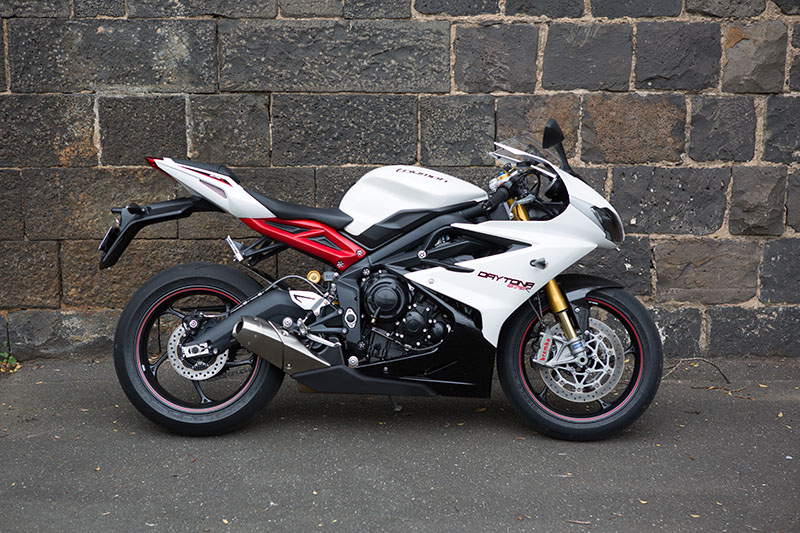
2014 - Daytona 675R
UK Prime Minister: David Cameron
Top of the UK singles charts: Pharrell Williams - Happy
Australian Prime Minister: Tony Abbott
Top of the Australian singles charts (July): The Madden
Brothers – We are done
If you were to look at the 675R’s place in the corporate history, you’d have to say it’s a reflection of how both the market and the company itself have shifted over time.
While market segmentation is nothing new, it has become more pronounced over the years. Take the pillion seats of the three bikes as an indicator. The T160 has a generous area with a grab handle and overall mirrors what’s available to the rider. On the Super III, the seat is still okay (so long as you’re small), but you have to remove the pillion seat cowl and fit the grab handle. On the 675, there’s a miniature replica of a pillion seat, but really whoever gets on needs to be small and very much in love with the rider. And not want to go further than the local milk bar…
As for the company, have a look at the catalogue and you’ll see that four-cylinder bikes by this time had disappeared. Consultants hired by Hinckley advised them long ago to drop machines like the Daytona 1200, even though a successor (Daytona 1300) was said to be close to production-ready.
Once again, just like Meriden, it was concentrating purely on triples and twins. It’s also smart enough to not take on the mighty Japanese makers head-on. No 600, 750 or one-litre narrow focus sports bikes. Nope, it has a slightly quirky 675 triple as its sports headliner.
Whether Triumph could successfully take on the Hondas of this world was thus rendered a moot point – it didn’t have to. The would-be 600 sports buyer would quite happily look at the slightly bigger Triumph, thanks, particularly given its reputation. (Triumph must also have looked askance at Yamaha’s then re-adoption of mid-range triples.)
The development roots of this generation Daytona go way back to 2001, while the launch of the 675 series happened in 2005 at the NEC show in the UK. Its reception was warm, with road tests of the period highlighting the value of that compromise between mid-size bike and a slightly ‘fat’ engine. Suzuki’s GSX-R750 probably owes its survival to that exact phenomenon. What you get is a bike that isn’t intimidating, but still goes very, very fast.
In the case of the 675R, it happily took on the role as the corporate performance flagship. Much of its appeal was owed not so much to cutting edge technology (most of the component features can be found on other models from other brands) but brilliant packaging.
For example, you got a claimed 128 horses punting a road bike that weighed mid 180s with fuel on board. You’re not exactly in the kilo per horsepower club, but we are still talking of a power to weight ratio that can only be dreamt of on the car world.
Front and rear you scored running premium Ohlins suspension, which kept the handling very sharp while successfully disguising the ride as something acceptable on the road.
Braking was current kit, with switchable ABS, and more than capable of meeting the machine’s performance needs.
Then there was that electronic quick-shifter, by then in its second software generation, which was as much a talking point as it is a riding tool. Add in the odd spot of carbon fibre panel and you have a pretty appealing package.
It’s a little on the tall side, but overall it’s comfortable enough for the style of bike it is.
Oh, and Triumph had even loosened up a bit to get involved (on a modest scale) with some racing. It was been rewarded with a couple of British 600 supersport championships – in 2008 and 2012 with Australian Glen Richards at the handlebars.
Where the 675R differed significantly from its predecessors is in its focus and market position. There’s no mistaking it for anything but a current single-purpose mid-range sports bike, and it just happens to be right up in the leading pack of that particular micro-market race.
More than the T160 and Super III, it represented a maker that is confident about its place in the market and is prepared to take on some pretty tough niches – or carve out new ones of its own.
Where it ends up sitting in the marque’s history in, say, 20 or 40 years, is harder to judge.
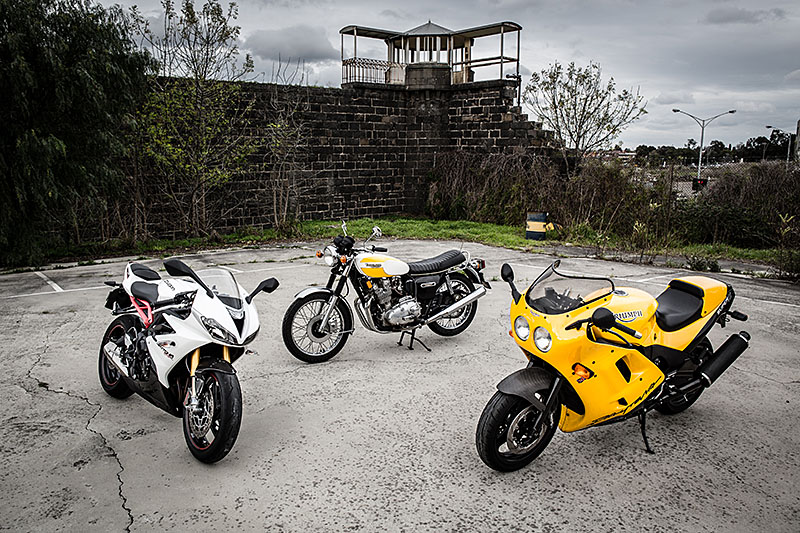
Spex
T160
ENGINE
Type: air-cooled in-line pushrod triple with two valves
per cylinder
Bore and Stroke: 67 x 70.5mm
Displacement: 741cc
Compression ratio: 9.5:1
Fuel system: 3 x 27mm Amal 626
TRANSMISSION
Type: 5-speed constant mesh
Final drive: chain
CHASSIS & RUNNING GEAR
Frame type: steel
Front suspension: Conventional 35mm fork, no adjustment
Rear suspension: twin shocks, preload adjustment
Front brakes: single 254 Lockheed disc
Rear brake: single 254 Lockheed disc
Front tyre: 410-19
Rear tyre: 410-19
DIMENSIONS & CAPACITIES
Dry weight: 228kg
Seat height: 810mm
Fuel capacity: 13 or 18 litre
PERFORMANCE
Max power: 58hp @7250rpm
Max torque: NA
Super III
ENGINE
Type: Liquid-cooled in-line DOHC triple with four valves
per cylinder
Bore and Stroke: 76 x 66
Displacement: 885cc
Compression ratio: 12:1
Fuel system: 3 x 36mm Mikuni CV
TRANSMISSION
Type: 6-speed constant mesh
Final drive: chain
CHASSIS & RUNNING GEAR
Frame type: Egli-style single spine steel
Front suspension: Conventional 43mm fork, full adjustment
Rear suspension: Monoshock, full adjustment
Front brakes: 6-piston 310mm twin discs
Rear brake: 2-piston, 255mm disc
Front tyre: 120/70-17
Rear tyre: 180/55-17
DIMENSIONS & CAPACITIES
Dry weight: 211kg
Seat height: 790
Fuel capacity: 25lt
PERFORMANCE
Max power: 115hp @9500rpm
Max torque: 8.3kg-m @6500rpm
675R
ENGINE
Type: Liquid-cooled in-line DOHC triple with four valves
per cylinder
Bore and Stroke: 76 x 49.6mm
Displacement: 675cc
Compression ratio: 12.65:1
Fuel system: Electronic injection
TRANSMISSION
Type: 6-speed constant mesh
Final drive: chain
CHASSIS & RUNNING GEAR
Frame type: cast alloy
Front suspension: USD 43mm Ohlins fork, full adjustment
Rear suspension: Ohlins monoshock, full adjustment
Front brakes: 4-piston Brembo 310mm twin discs
Rear brake: 2-piston Brembo 220mm disc
Front tyre: 120/70-17
Rear tyre: 180/55-17
DIMENSIONS & CAPACITIES
Wet weight: 185kg
Seat height: 820mm
Fuel capacity: 17.4lt
PERFORMANCE
Max power: 128hp @12,500rpm
Max torque: 7.54kg-m @11,900rpm
-------------------------------------------------
Produced by AllMoto abn 61 400 694 722
Privacy: we do not collect cookies or any other data.

Archives
Contact



